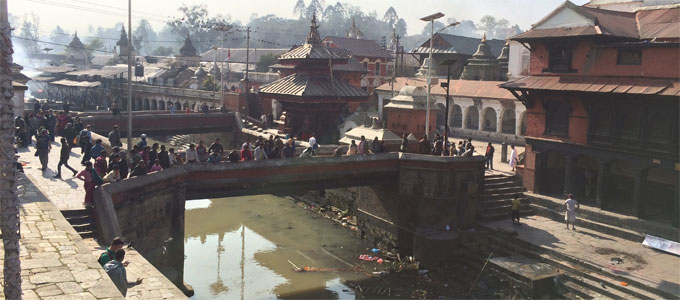Nagmati Dam, Kathmandu

Client: Department of Irrigation, Nepal
Location: Kathmandu, Nepal
Date: 2015 – 2018
Providing an environmental flow to improve environmental and community outcomes for Kathmandu
Background
Kathmandu, the capital of Nepal, is home to more than five million people. High population growth in Kathmandu over the past 30 years has put a serious environmental strain on the Bagmati River. Although a holy river, the Bagmati River is highly degraded, with reduced flows, high pollution, and a damaged freshwater ecosystem.
To revive the Bagmati River, the Government of Nepal embarked on the Bagmati River Basin Improvement Project with funding from the Asian Development Bank.
One of the subprojects was the construction of a dam on the Nagmati River to store water during the monsoon period for environmental release during the dry season. This in turn would improve river water quality, provide sufficient quantities of water for religious and cultural events, and some much-needed recreational assets and improved amenity for the city of Kathmandu.
Solution
From November 2015, Entura was involved in the investigation and detailed design of the Nagmati Dam in two stages. Stage 1 included a revision of the draft feasibility study of the dam with additional investigations and specialist studies. Stage 2 work started in February 2017 involving the preparation of detailed designs and construction contract documentation.
Through a simple storage model, it was determined that 8.2 Mm3 of live storage was required to meet the flow objectives. However, to provide some contingency to allow for various uncertainties, the final live storage adopted was 8.8 Mm3. To achieve this storage a 95m-high dam was required at the Nagmati site.
Entura undertook the detailed design of Nagmati Dam as well as a small hydropower plant at the storage discharge location on the Bagmati River, some 3 km downstream.
A concrete-faced rockfill dam (CFRD) was the best option for this site predominantly due to the challenges associated with the location, foundation conditions, available materials on site and the seismic environment.
Outcome
The major outcomes of this project were the detailed design of:
- a 95m-high and 550m-long concrete-faced rockfill dam
- frontal approach spillway with an Ogee crest 20m long located on the right abutment. The spillway chute is 244.3 m long at the end of the flip bucket
- plunge pool (45 x 20m) at a distance of 40m from lip of the flip bucket for energy dissipation
- 5m-diameter diversion conduit
- 5m-diameter outlet conduit with a 1.5m-diameter Howell-Bunger valve at the end
- 4m-diameter escape pipe to provide riparian flows immediately downstream of the dam and a 0.6m-diameter penstock pipe bifurcate from the outlet conduit around the toe of the dam.
- 4 km penstock pipeline to a 2.12 MW power station.
The Nagmati Dam will contribute to improved river water quality, sufficient water for religious and cultural events, recreational assets and improved amenity. It will also contribute to water security and resilience to potential climate change impacts.
Entura overcame a range of challenges to deliver a successful outcome, including the restrictions associated with the location of the site in a national park, presence of a significant downstream population, and a high seismic environment.
The development of a small hydropower station provides an ongoing revenue stream to ensure that funds are generated for the operation and maintenance of the overall dam project, thus ensuring its sustainability.


